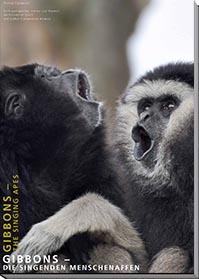
Gibbons – The singing apes
Gibbons – Die singenden Menschenaffen
Thomas Geissmann
ISBN 978-3-033-04475-3, 2014, Paperback, 48 pages. Anthropologisches Institut und Museum der Universität Zürich, and Gibbon Conservation Alliance, Zurich, Switzerland.
Language: English and GermanYou may download the whole book as a PDF file (6 MB).
Download begins if you click here.